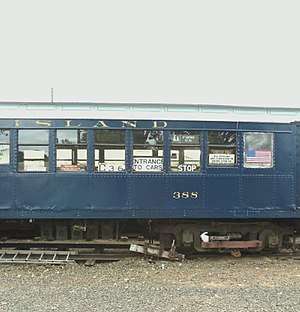ME-1 (New York City Subway car)
The ME-1 (also known as MU-1 or MUE-1) was a rapid transit car built from 1925 to 1926 by the Standard Steel Car Company. They were primarily used on the Staten Island Railway and later also used in the New York City Subway. 100 cars were built, numbered 300–389 (motors), and 500–509 (trailers). They were the first electric cars to run in revenue service on the SIRT.[1]
| ME-1 | |
|---|---|
 SIRT ME-1 Car 388 on display at the Shore Line Trolley Museum in 2010. | |
| In service | 1925–1973 |
| Manufacturer | Standard Steel Car Company |
| Replaced | 1973 |
| Constructed | 1925–1926 |
| Number built | 100 (90 Motors, 10 Trailers) |
| Number preserved | 2 |
| Number scrapped | 98 |
| Fleet numbers | 300–389 (motors) 500–509 (trailers) Note: Trailers 502, 505–507, and 509 converted to motor cars 390–394 in 1928 |
| Capacity | 240: 71 (seated) 169 (standing) |
| Operator(s) | Staten Island Railway New York City Transit Authority |
| Specifications | |
| Car body construction | Steel |
| Car length | 67 ft 3 in (20.50 m) |
| Width | 10 ft 0 in (3,048 mm) |
| Height | 12 ft 1.125 in (3,686 mm) |
| Floor height | 3 ft 9.125 in (1.15 m) |
| Doors | 6 |
| Maximum speed | 60 mph (97 km/h) |
| Weight | Motor car: 95,750 lb (43,430 kg) Trailer car: N/A |
| Traction system | Motor car: GE PC 10L using GE 282A motors (200 hp each). 2 motors per car (1 per truck). Trailer car: None |
| Power output | 200 hp (149 kW) per traction motor |
| Electric system(s) | 600 V DC Third rail |
| Current collection method | Top running Contact shoe |
| Braking system(s) | WABCO Schedule AMUE with UE-5 universal valve, ME-30 brake stand, and simplex clasp brake rigging |
| Coupling system | WABCO H2A |
| Track gauge | 4 ft 8 1⁄2 in (1,435 mm) standard gauge |
The ME-1s entered service in 1925 and ran continuously on all three SIRT lines. Sometime between 1953 and 1954, 25 cars were purchased by the New York City Transit Authority to run on the subway. Numbered 2900–2924, these cars were nicknamed B-29s, a reference to a large aircraft of the same name, due to their large size (67 feet or 20.42 meters) and the fact that they had been renumbered for subway service into the 2900s. The NYCT cars continued to run until 1961, when they were replaced by the R27s and R30s. The SIRT cars lasted until 1973, when they were replaced by the R44s. Two cars were preserved, while the rest were scrapped.
Service history
A total of 100 cars were purchased from the Standard Steel Car Company[2] – 90 motors and 10 trailers. The 90 motors were built in 1925, and the 10 trailers in 1926. Five trailer cars were later rebuilt as motors in 1928.
Purchased by the Staten Island Rapid Transit's former operator, the Baltimore and Ohio Railroad, the cars were built to replace steam-powered equipment on the railroad, and in preparation for the Staten Island Tunnel connection to the BMT Fourth Avenue Line in Brooklyn. Because of this, the cars were built to Brooklyn–Manhattan Transit Corporation (BMT) subway specifications, and strongly resembled the BMT's AB Standard.[2][3][4] The cars debuted in 1925, shortly after the electrification of the railroad.[2][3] They ran continuously on the three SIRT lines (North Shore Line, South Shore Line, South Beach Branch) until 1953, when the South Beach Branch and North Shore Line closed.
In 1953–54, 25 of these cars were purchased from the SIRT by the New York City Transit Authority to run over former BMT lines and did so until 1961, when they were replaced by the R27s and R30s.[2]
The remaining 48 cars (many had been lost in several fires)[2] soldiered on the remaining SRT Main Line. Due to the shortage of equipment, all but four cars would be used in peak operation.[2][5] They continued to run until 1973, when they were finally replaced by the R44s.[6]
Two cars have been preserved:
- Car 388 – Shore Line Trolley Museum in East Haven, Connecticut.
- Car 366 – Seashore Trolley Museum in Kennebunkport, Maine.
Car 353 had survived on a track in the Travis Yards[7] and was acquired by the Trolley Museum of New York, based in Kingston, New York.[8] However, the car was scrapped sometime around 2004 or 2005 before transportation was able to be arranged to Kingston.
See also
- AB Standard, a similar car built for the New York City Subway by both the Pressed Steel Car Company and by the American Car and Foundry Company.
References
- Ponder New Law. The New York Times, June 5, 1923.
- Leigh, Irvin; Matus, Paul (January 2002). "Staten Island Rapid Transit: The Essential History". thethirdrail.net. The Third Rail Online. Archived from the original on May 30, 2015. Retrieved June 27, 2015.
- Pitanza, Marc (2015). Staten Island Rapid Transit Images of Rail. Arcadia Publishing. ISBN 978-1-4671-2338-9.
- "Staten Island Is Not a Commuting Community". Brooklyn Daily Eagle. October 5, 1924. p. 67. Retrieved April 26, 2016 – via Newspapers.com.
- "Staten Island Railway". stationreporter.net. Archived from the original on February 15, 2010.
- "New York's R-44 cars enter service". Railway Gazette International. July 1972. p. 275.
- "Abandoned 1925 vintage Staten Island Rapid Transit car 353 – 2003. - ltvsquad.com". ltvsquad.com.
- "Showing Image 31284". nycsubway.org.